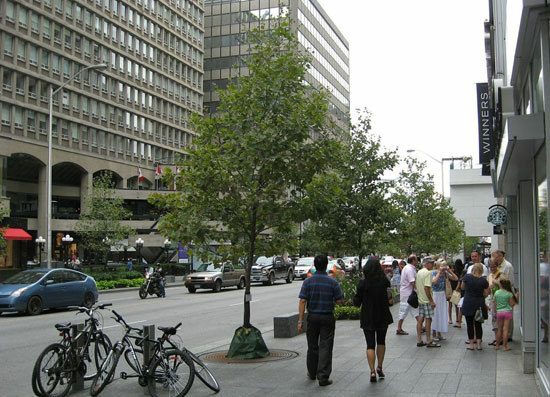Trees Need Dirt
The soil cells in the Bloor Street project meet a number of new design criteria for urban forestry in that they provide the required amounts of soil, they capture rain water and help to manage storm water runoff, they use captured rain water to irrigate the newly planted trees, they satisfy engineering loading requirements for pavements and both new and existing utilities were integrated into the soil cell system.
 |
The City of Toronto, Canada used a soil cell system to plant 138 London Plane trees and capture rain water along six blocks of Bloor Street in their downtown area. Photo courtesy of DeepRoot Green Infrastructure |
How Much Does it Cost?
Earlier in this article we briefly compared the soil cell system to structural soils. The soil cells system is initially be more expensive than the structural soil system and definitely more expensive that the initial cost of conventional planting of trees in a small tree pits. However, studies have shown that the soil cell system is comparable to the cost of using structural soil on a net soil volume basis. Long term costs have not been studied but there may be a definite long-term savings in cost over conventionally planted trees as a soil cell system provides a longer life span for the tree, reduces issues with tree root heaving of pavements and reduces issues with storm water flooding and management in urban areas.
Conclusion
Emerging Trends Relating to Urban Trees
Municipalities are implementing minimum soil volumes for tree plantings. The most ambitious of these tree-planting programs is in Toronto, Canada where there is a requirement for 30 cubic meters (1,056 cubic feet) of soil per tree. A soil cell system allows this large volume of soil to be provided without compromising the visual design of the project. With a soil cell system, pavements and other site elements can be installed with the required compaction densities without compromising the volume or quality of the underlying soil. A soil cell system can also be used in areas where bio-retention swales and rain gardens are inappropriate or cannot be used.
Municipalities are also implementing more stringent storm water management regulations and in some instances enacting storm water utility fees when a project is not able to adhere to these newer regulations. These new regulations incentivize developments that keep storm water on the site and manage it at the source. A soil cell system provides a means of managing storm water at the source where it hits the ground. The large volume of soil within a soil cell system has a high water absorption capacity and is able to filter pollutants through the fine-grained slow draining soil.
Sustainability standards and criteria that address heat island effect, storm water capture and management and treatment of polluted storm water can all be addressed through the use of a soil cell system which provides more supportive and sustainable growing conditions for urban trees.
The Advantages of a Soil Cell System in Urban Projects
A soil cell system provides designers with the ability to meet the challenges of urban environments and install trees in more locations, in better growing mediums and in a more sustainable manner. As a soil cell system provides larger volumes of soil, it provides trees more room for root expansion and also allows for a greater variety of tree species to be planted. In a soil cell system the soil is less compacted and more friable with extensive air and water spaces, thus creating a better growing medium for trees. The system also allows designer to use a broader range of soils in the tree planting medium and this can be a cost and energy savings as more local in-situ soils can be utilized without the need for transporting soils to the project site. The system with its modular frames allows trees to be installed within the existing framework of utilities, again providing another cost saving measure to the project as utilities need not be relocated. A soil cell system can help to meet sustainability criteria and new sustainable codes and guidelines as the system can absorb rain and surface water and assist in the management of storm water and the treatment of TSS pollutants.
References:
1. National Wildlife Federation and American Forests
2. Urban, James, Growing the Urban Forest, City of Toronto, Tree Symposium: Healthy Trees for a Beautiful City, 2004.
3. Sustainable Cities Institute: Benefits of Trees & The Urban Forest
Additional References:
J. Urban 2008-2010; Observations by J. Urban between 2008 and 2010; Staten Island Ferry Terminal Plaza, New York, NY; Union Square, New York, NY; Mission District, San Francisco, CA; Various Streetscape Installations, Chicago, Il; Lancaster Avenue Streetscape, Ft. Worth, Texas. Preparation for ASLA National Conference Debates on Soil Below Pavements.
Q. Xioa, G. McPherson 2008; Urban Runoff Pollutants Removal of Three Engineered Soils, UDSA Center For Urban Forest Research, August 31, 2008.
American Society of Consulting Arborists, Arboricultural Consultant; Vol. 46 Issue 2 2013; Two Different Approaches to Improve Growing Conditions for Trees: Comparing Silva Cells and Structural Soil by James Urban, FASLA, ISA. The Why's and How's of Using CU-Structural Soil® to Grow Trees in Pavement by Nina Bassuk, Ph.D., Cornell University.
 |
Our mission is to create a more livable built environment, providing a high level of ecosystem services, by using green infrastructure like trees, soil, and on-site stormwater management. DeepRoot was founded in 1976 when an industrial designer tripped on an uprooted sidewalk and ruined a new pair of shoes. From these humble beginnings grew a leading company with passion for enhancing the built environment through the design and use of innovative quality products. www.deeproot.com |








